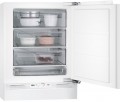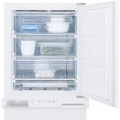Slim shelf
The slim shelf is a low (up to 5 cm) tray, and is best suited for storing seasonings, rolled puff pastry, ice, butter and other small-sized products. In such a container, you can’t place products on top of the other, so finding the needed frozen item will be much easier.
Power failure autonomy
The amount of time the freezer keeps food cold enough when the refrigeration system is turned off, for example, due to a breakdown or power outage. Technically, the power failure autonomy for each model is calculated differently; For example, for a freezer with an operating temperature of -18 ° C, this is the period during which the products in the chamber heat up from -18 ° C to -9 ° C. To sum up, the time is indicated during which the frozen products are guaranteed not to heat up to a temperature at which they could lose their properties.
Energy consumption per year
It is the average amount of energy consumed by the freezer in a year of operation. Of course, these figures are not absolutely accurate. The actual power consumption may vary depending on the specific operating conditions. However, this parameter makes it possible to evaluate the consumption of the device and compare different models with each other. At the same time, it often turns out to be more convenient and visual than the energy consumption class (see above) because, in this paragraph, we are talking about a specific figure (from which you can also calculate the cost of electricity consumed).
Climate class
The climate class to which the freezer corresponds.
As the name implies, this parameter describes the environmental conditions for which the unit is designed. The warmer it is around, the more powerful the freezer should be and the better thermal insulation it should have. Specific classes are indicated by letters. Here are the most popular options:
— SN (subnormal). Models for a cool temperate climate have an operating range from +10 °C to + 32 °C. Such a unit can be useful in a poorly heated room where the temperature can drop below +16 °C — for example, on the veranda of a private house, in a garage, etc.
— N (normal). Freezer for a temperate climate, with an operating temperature range of +16...+32 °C. Such a unit is suitable for most residential apartments and houses in mid-latitudes.
— ST (subtropical). Models for subtropical and humid tropical climates. Normally they work at the range of external temperatures +18...+38 °C.
— T (tropical). Refrigerators for dry tropical climates. Designed for temperature range +18 °C to +43 °C.
Also, note that there are many models on the market with an extended temperature range covering several classes. For example, a unit labelled N-ST will have a temperature range of +16...+38 °C. These freezers are indispensable in climates, conditions which are not covered by one standard class — for example, in cold winters and hot summers.
Noise level
The average noise level generated by the freezer during operation. The quietest models give out about 25 - 30 dB — this is the average noise background in a residential area at night (comparable to the ticking of a wall clock); the loudest — is about 60 dB (loud conversation). More detailed comparison tables can be found in special sources.
In any case, the lower the noise level, the more comfortable the use of the unit. However, it does not always make sense to look for the
quietest freezer: in some situations (for example, in a noisy workshop), the freezer's sound may be lost against the surrounding noise background. In addition, reduced noise often affects the price.
Country of origin
It is the country in which, according to the manufacturer, this or that model is manufactured. Even though most of the capacities are concentrated in China, European factories for the production of household appliances have not disappeared. And some models can be produced there. In general, such a division into a Chinese or European factory should not particularly affect the quality of products, but the stereotype of a reliable European assembly is present. However, it is possible that the model may have a country of manufacture, for example, Poland, and in the store under the same article, you will meet China.

